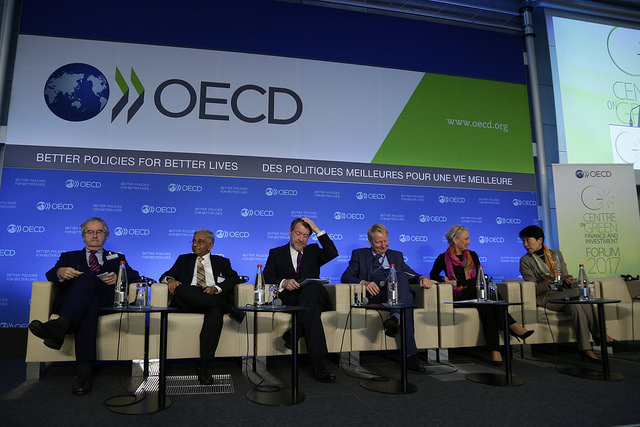Green Bonds: How to Fund Climate Change Initiatives

As the OECD’s fourth Green Investment Financing Forum convened in Paris on the 24th and 25th of October 2017, much of the discussion centred around expanding investment in green bonds. Green bonds are financial instruments that account for a growing investment market. With the same risks and returns as regular bonds, they offer a good opportunity to invest in pro-environment projects. In the past couple of years, demand for green investment opportunities has skyrocketed. Forums, similar to that of the OECD, bring public and private banks together to discuss how to bring more investors into green banking. Green bonds provide an opportunity for investors to support climate change initiatives, as well as provide more opportunities for green projects to get off the ground given sufficient financial resources. The advent of green bonds are becoming increasingly important upon the implementation of the Paris Climate Agreement, and as deadlines to reduce carbon emissions loom closer.

What qualifies as a green bond can vary depending on the issuer. The Green Bond Principles are set of rules that codify and determine the criteria of what makes a bond green. These principles were set forth by a diverse group of green bond issuers with the hopes that these principles will improve the stability of the market and encourage more investment through standardisation of guidelines and available information. The 2017 standards outline four core components that can be used to evaluate green bonds: use of proceeds, process of project evaluation and selection, management of proceeds, and reporting. The use of proceeds refers to the types of projects that can be funded, and lists a wide variety of projects as examples. These standards help to ensure transparency with investors, and recommend a third party review for accountability.
The World Bank was the first to start issuing green bonds in 2008. Since then, several private and public banks have begun to offer their own versions of the green bonds. These bonds range from investment in solar energy to infrastructure projects that help to mitigate the effects of climate change. Green bonds should be particularly attractive for investors interested in sustainability, and for those that genuinely believe in the return potential of the green market considering the widespread legislated measures taken globally to improve the environmental status.
Apart from aiding governments to reach internationally instated climate goals, green bonds have a variety of benefits. Firstly, green bonds encourage transparency that is not necessarily present in typical bond markets. Issuers must justify exactly how bonds qualify to be a green one, and must specify the project they wish to finance, in order to ensure that investors make informed decisions. Transparency also allows investors to hold bond issuers accountable and keeps investors in the loop on the development of issuers’ long term sustainability plans. Secondly, green bonds also promote the idea that sustainability is relevant through every aspect of a business, and not just relegated to a specific department by encouraging the integration of finance and sustainability departments. Moreover, green bonds exemplify a holistic and well-integrated model of sustainability. Finally, the green bond market may be relatively easy to develop since its structure mimics regular bond markets quite closely. Hence, the green market would merely require some additional regulation.
Despite, the recent success of the green bond market, there are still several barriers preventing the full development of this new portion of the economy. The Green Bond Principles referenced earlier are one set of voluntary international standards that can vary, thus not constituting binding status. As a result, only about 60 per cent of green bonds have been verified by a second party review. Furthermore, commercial banks may prioritise attracting investors over following high standards of transparency to ensure the “greenness” of their bonds. In some cases the development of green bonds is merely a repackaging of projects that would be funded anyway, a tactic called “greenwashing“, that attempts to attract new and different investors. Many of the banks increasing green financing still spend significantly more on financing “black” bonds that funnel money into the coal and fossil industry.
Nevertheless, the green bond market is key to encouraging the world economy t0 investment in a sustainable future.

About 81 billion dollars were invested in green bonds in 2016 according to the Green Bond Initiative. This figure is a 92 per cent increase from green investment in 2015. Last year also saw new agents entering the green bond market, particularly federal and municipal governments from around the world, with an increased prevalence of green bonds in Asia. This suggests a promising future for green bonds if the current rate of growth continues.
Much of the discussion at the Green Finance Forum this year has revolved around the question of obtaining 1 trillion dollars of investment by 2020. This is an important year for the progress of sustainability, especially since climate scientists have grimly estimated that it will be impossible to attain the Paris Agreement’s climate standards by 2020 with current efforts and resources. Failing to reach these standards will likely result in irreversible climate damage, which gives the role of green bonds even more importance and urgency. In order to reach this goal, most governments would need to put greater emphasis on low-carbon or green projects. Additionally, emerging economies, in particular, struggle with low credit ratings for issuers. This means it is much harder for local banks in developing countries to issue attractive green bonds, making it harder to finance sustainable development where it is needed most. By addressing these issues and establishing standardisation in green bonds, 1 trillion dollars might become a realistic endeavour.
The use of green investment as a publicity tool suggests that global markets recognise the importance and value of investing in climate change initiatives. Governments and corporations must leverage growing interest in sustainable investment to work toward reducing carbon emissions and facilitating sustainable development, as outlined in the Paris Agreement. Thus, the growth of the green bond industry offers a seriously profitable source of funding for the sustainability projects that we are in dire need of.
Edited by Arnavi Mehta.
